 TOA
PAYOH VETS TOA
PAYOH VETStoapayohvets.com Date: 10 June, 2009 |
|
|||||||||||
|
|
|||||||||||
 TOA
PAYOH VETS TOA
PAYOH VETStoapayohvets.com Date: 10 June, 2009 |
|
|||||||||||
|
|
|||||||||||
|
SPAYING PROCEDURES PERFORMED BY DR SING FROM 2005 |
|
| Absorbable sutures, antibiotic powder and a plaster are used in dog spays at Toa Payoh Vets. Some owners are concerned about the length of the skin incision. They compare and contrast with other friend's female doges spayed. They assess that a veterinarian who spays with the shortest skin incision is more competent. Shorter incisions can only be achieved using the spay hook and if there are no complications during surgery. Antibiotic powder may be used to cover the skin incision wounds before plastering. Dogs will be given pain-killers and antibiotics after the spay. | |
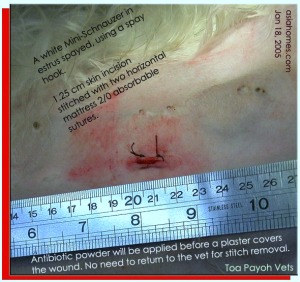 |
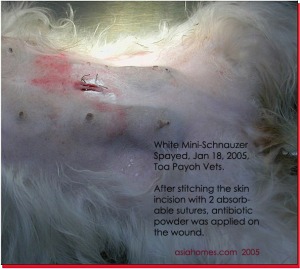 |
|
The shortest incision is
around 1.25 cm long for a spay hook removal. A longer incision may be necessary depending on the location of the ovaries and uterus, bleeding complications and the experience of the veterinary surgeon. |
Antibiotic powder covers the dried wound area. From 2005, antibiotic powder or antibiotic injections is used instead of antibiotic cream |
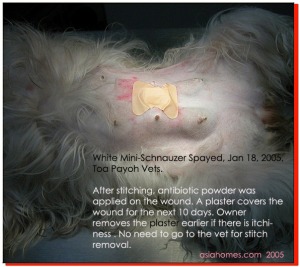 |
|
|
A plaster covers the wound
for the next 10 days. It may be removed earlier if the female dog feels itchy. Consult your vet at Toa Payoh Vets. |
|
|
SPAYING PROCEDURES PERFORMED BY DR SING IN 2003 |
|
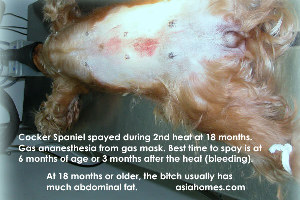 |
 |
|
A Cocker
Spaniel in her 2nd heat (vulva swollen) on the operating table. After tranquilisation, she was given an anaesthetic gas using a gas mask. In most cases, the mask is replaced by a breathing tube (endotracheal tube). |
A 1.5 cm skin cut is made. The muscles and peritoneum are then incised at the mid-line. A spay hook is inserted into the abdomen to fish out the uterine horn. The above picture shows the hook during the spay of a Jack Russell as no photograph was taken for the Cocker Spaniel. |
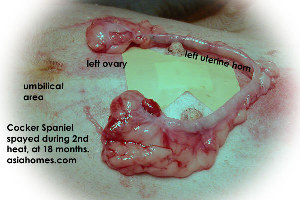 |
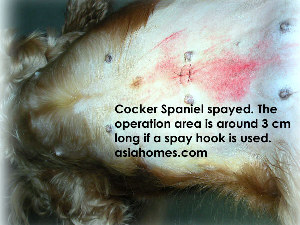 |
|
If the female
dog
is on heat, the uterus and blood vessels are fragile. In rare
cases, there is bleeding as the vessels disintegrate under the clamping by forceps. The vet has to make a long skin incision to check for the source of and to control bleeding to prevent death. |
Some pet owners are concerned about the length of the skin incision as they contrast and compare the incision lengths of their friends' spayed dogs. |
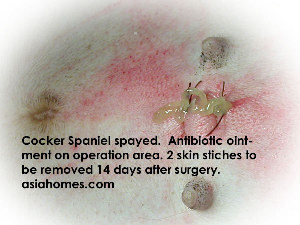 |
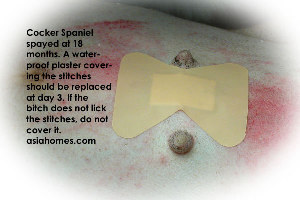 |
|
In 2005, in Toa Payoh Vets,
absorbable stitches are used. They need not be removed as they dissolve later. There is no need to see the vet for stitch removal. Antibiotic powder is used for the wound instead of antibiotic ointment. If non-absorbable nylon stitches are used, please get them removed at day 14. |
A water-proof
plaster prevents the female dog licking her wound. Replace the plaster
3 days later. If the female dog does not lick the wound, there is
no need to replace the plaster.
Usually the plaster can be removed at day 10. Any swelling of the
wound due to licking should be referred to the vet. The female dog goes home in the afternoon in uncomplicated cases. You can request for your female dog to stay over-night to rest at the Surgery. |
|
DR SING'S RECOMMENDATIONS FOR SPAYING A FEMALE DOG |
|
|
Females to be spayed 3
months after the first heat. |
|
|
SURGERY CASE - SPAYING DURING THE DOG'S HEAT PERIOD |
|
|
"Red blood staining the bed, the floor, the sofa sets and all over the apartment," the first-time owner of female dogs aged from 6 - 8 months complained. "It is such a chore to clean up. Other family members are upset by the dirtying of the flat." So the owner went to the vet to get the female dog spayed immediately. In this operation, the ovaries and uterus of the female dog is removed. "It will not be in the best interest of the female dog as there is a rare possibility of bleeding complications during or after surgery," I advised. "Bleeding may or may not lead to the death of the female dog after surgery". "So, you can't perform the surgery?" the first-time owner asked me when I explain that the blood vessels and the womb are more fragile during the heat period and bleed easily when they are clamped by forceps during the operation. "Well, other vets can do it." Therefore, I must be incompetent as I can't even "spay" a female dog. Sometimes, the bad mouthing of such prospective clients to their friends harms the reputation of the veterinarian. There is no point telling the prospective client that it is not in the best interest of the female dog to spay her when the owner has to clean up the apartment for the next 10 - 14 days. There are new pet owners who do understand the risks and take my advice to delay surgery till 3 months after the end of the heat. Pet shops do sell the protective pants to prevent the blood staining the apartment, but that means more financial expenses. An advantage of spaying 3 months after the end of the heat is that the female dog has time to mature. It is in the best interest of the female dog, but this may not be in the best interest of the uneducated owner. So, do I turn away the female dog on "heat"? And lose revenue to other vets. And lose respect from new clients? If I have the trust of the pet owner, I will advise delaying the surgery to 3 months after the heat. The female dog usually comes into first heat at 6 - 8 months of age. The subsequent heat is usually 6 monthly. A spay is a major surgery although it is a common procedure and nearly 100% of the female doges do not die from such surgeries. Unless there are bleeding complications not detected by the veterinarian. The alternative is to spay the female dog at 6 months of age, before the onset of heat. There are recommendations by the American Veterinary Medical Association in 1993 to spay at 8 - 16 weeks of age (see References below) in an effort to control strays. If owners wish to spay their dogs at less than 6 months of age, please let us know. The puppy must be healthy and not suffering from kennel cough, hypothermia or hypoglycaemia. |
|
|
EARLY SPAY/NEUTER: AN OVERVIEW |
|
|
By Theresa A. Fuess, PhD, VM-3
This
resolution (1) passed an AVMA House of Delegates vote in the
summer of 1993 and has also been approved by the ISVMA**.
As with other AVMA positions, it is up to each member to
decide whether to adhere to this guideline. Having been taught
that 6 to 7 months of age is the proper time to spay/neuter
puppies and kittens, and having no information regarding the
effects of early spay/neuter on the long-term health of the
animal, many veterinarians have been reluctant to advise their
clients to have their pets spayed/neutered at 6 to 7 weeks
of age. However, there is an accumulating body of evidence
indicating that the positive results quite possibly outweigh
any remaining unknown risks.
* American Veterinary
Medical Association |
|
|
REFERENCES: 1. It's possible to spay a dog during estrus, or heat, but it's not the best time. Most veterinarians prefer not to spay a dog in estrus because the uterine tissue can be swollen, fragile, and more prone to damage. Dogs also have a tendency to bleed more when they're in heat. Because of this, estrus makes surgery more risky for dogs. Most veterinarians prefer to delay spaying a dog until she has been out of estrus for a month or more. Since a recently spayed dog may still be attractive to males, performing the surgery during heat will not stop your neighbours' dogs from looking for your female dog. Keep her inside and have your veterinarian perform surgery 3 months later. 2.
www.asiahomes.com/singaporetpvet/dogs/0706JackRussell_spay.htm
4. www.la-spca.org/early_spay_neuter.htm (Louisiana SPCA report) |
|
|
Copyright ©
Asiahomes Internet |
|